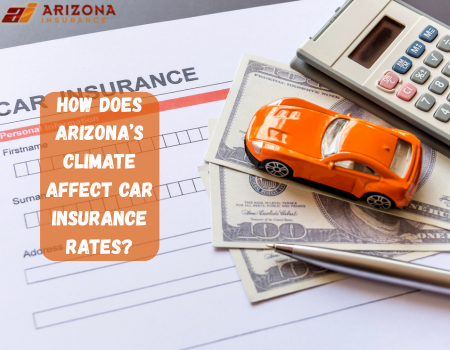Arizona is known for its striking desert landscapes, year-round sunshine, and dramatic seasonal weather shifts. But while the beauty of the state is undeniable, its climate can pose unique risks for drivers — and those risks can influence how much you pay for car insurance.
From blistering summer heat to intense monsoon storms, Arizona’s weather conditions create hazards that insurance companies factor into the premiums they charge. If you’ve ever wondered why your car insurance might seem higher here compared to other states, the climate is part of the reason. Let’s break down how Arizona’s environment affects your rates and what you can do to stay protected.
How the Weather Can Impact Your Car Insurance
 Extreme Heat and Vehicle Wear
Extreme Heat and Vehicle Wear
Arizona experiences some of the highest temperatures in the United States, especially in cities like Phoenix and Yuma, where summer highs often surpass 110°F. While this dry heat might be easier on the body than humid conditions elsewhere, it takes a toll on vehicles.
Prolonged heat can:
- Weaken tires, increasing the risk of blowouts
- Cause battery failure faster than in cooler climates
- Put stress on engines and cooling systems
- Lead to damaged interiors, faded paint, and cracked dashboards
These heat-related issues increase the likelihood of accidents or breakdowns on the road, prompting insurance providers to factor higher repair and maintenance risks into their pricing, leading to higher car insurance premiums.
Monsoon Season Hazards
Between mid-June and September, Arizona’s weather dramatically shifts as monsoon storms sweep across the state. These storms bring intense rain, flash flooding, high winds, and dust storms (known locally as haboobs).
Monsoon-related driving hazards include:
- Low visibility from dust and heavy rain
- Hydroplaning on wet roads
- Falling debris like tree branches or power lines
- Flash floods that can damage or sweep away vehicles
Insurance companies analyze claim data and patterns — and areas prone to frequent monsoon damage may see higher comprehensive and collision coverage rates. If you live in a flood-prone neighborhood or a region with a history of storm-related claims, you could end up paying more for coverage.
Increased Theft and Vandalism Risks
Believe it or not, climate also indirectly influences the rates of car theft and vandalism. In hotter climates, vehicles are often left unlocked with windows cracked or doors open in an attempt to beat the heat — creating opportunities for thieves.
Additionally, during major storms, abandoned or unattended vehicles can become easy targets for vandalism or theft. Since areas with higher rates of these crimes tend to have increased insurance premiums, climate-driven conditions in Arizona can have an impact here too.
Wildfires and Smoke Damage
Arizona is no stranger to wildfires, particularly in dry, windy months. Wildfire season can stretch from early spring through late fall, with flames, ash, and smoke causing property damage to homes and vehicles alike.
While your comprehensive car insurance typically covers wildfire damage, insurers in wildfire-prone areas may adjust premiums to account for the increased risk. Smoke and ash can harm your car’s paint, filters, and interior, leading to additional claims that insurers factor into their pricing models.
Road Surface Wear
Arizona’s extreme temperatures, sudden downpours, and desert conditions wear down roads faster than in milder regions. Damaged road surfaces like cracked asphalt, potholes, and uneven pavement can raise the risk of accidents and vehicle wear.
Insurance providers often consider the quality of local road infrastructure when determining premiums. In areas with poorly maintained roads or frequent repairs, higher accident rates and repair claims tend to follow — contributing to insurance rate increases.
How You Can Protect Yourself and Your Rates
While you can’t control the weather, there are steps you can take to protect both your vehicle and your car insurance costs:
- Park in covered or shaded areas whenever possible to avoid heat and storm damage
- Avoid driving when monsoon alerts or dust storm warnings are in effect.
- Install anti-theft devices for added security
- Keep your car well-maintained to prevent breakdowns in extreme conditions
- Review your comprehensive and collision coverage to ensure it adequately covers climate-related risks
- Shop around for quotes — some insurance companies offer discounts for drivers who take extra safety precautions or drive fewer miles
Arizona’s unique climate has a significant impact on car insurance rates, with factors like intense heat, monsoon storms, wildfires, and road wear increasing risks for both drivers and insurers. By understanding how these environmental conditions affect your policy pricing, you can make smarter decisions about your coverage and vehicle care.
If it’s been a while since you reviewed your car insurance policy, now might be a good time to revisit your coverage — and make sure you’re adequately protected against everything the Arizona desert might throw your way.
